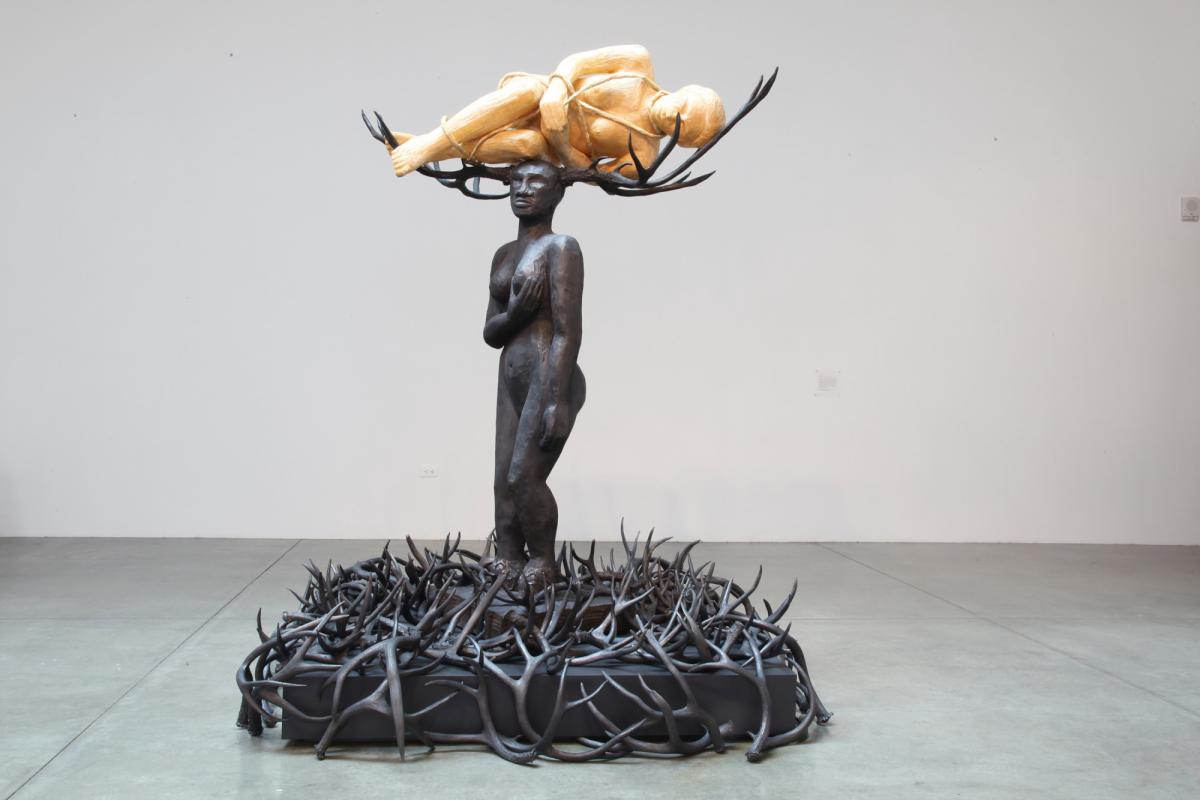The word "rouse" means to awaken and animate, and this sculpture by artist Alison Saar evokes the self-awakening and personal transformation we often experience when encountering a turning point in life. Saar made Rouse when her daughter left for college. The artist began thinking about "being menopausal . . . moving into new territory in my work . . . ready to let this other part of me mature and come out and be realized."
The massive antlers cradle a delicate, translucent adult figure in a fetal position, like a creature preparing to emerge from its cocoon. Scattered on the ground below are antlers that suggest a root network and, as the artist notes, mark "the passage of time to bring a child to adulthood."
Alison Saar’s sculptures and installations are rooted in her interests in materiality and histories of art, religion, and spirituality from a global range of communities, including the African diaspora and Indigenous peoples, among others.
Recently, Saar spoke in depth with the Smithsonian American Art Museum about Rouse, part of the museum's permanent collection; her journey as an artist, daughter of artists, and mother; and reflected on her use of materials and the impact of the world on her own work.
On materials and the history of objects:
I was immediately drawn to sculpture. I mean, I'm a very tactile person[...] but usually that's very much part of my conversation is having my hands involved in it. And I think collecting objects and being really interested in the history of objects was one thing. And then of course, my mother being an assemblagist, [...] one of our family outings would be go to flea markets or estate sales to find stuff. But I was really interested in transforming and using... I think a lot of it came out of what materials were accessible.
On working with wood and having a dialogue with the materials:
I think what I do love about working with wood is that it has this life essence to it. I love the smell of sawdust, and when you're cutting into things [...] I see that process is a collaboration because often the wood's got its own mind as to what it does and doesn't want to become. We used sometimes have wrestling matches between what I want it to do and what it wants to be sort of thing. So, I love that. I love that exchange with the material.
On the connection between an artwork and the viewer:
[T]hat's the one thing I think an artist doesn't want to do, is whispering in their viewer's ear. The most powerful works are the works that do not dictate what they're about. And in order for them to really relate to their view, or they have to somehow connect in a way that I would have no understanding of specifically. And that's the beauty again, that it's art, that it's not a language. It's not defined by specific words or specific ideas, that it can take you other places.
On identity as an artist, and as a mother:
I was very much dealing with this emptiness syndrome, which is kind of curious because as an artist with a very active career at that time, it still felt like the rug was being pulled out from under me. And that I realized that taking kids to school and picking them up and making their lunch and whatever else I needed to do to keep them afloat was very much part of my routine and very much part of my identity.
And so, when she was away from the home and I started questioning, I never really... If I'm not a mother, then what am I, which is bizarre. And having been raised by a mother who was a working mother all the time. So the career was always there, it felt like a constant, but this other thing. [...] I was trying to think of who I was. And so initially the piece is a figure who is between two worlds. She has this animal self, which is this deer hooves, and these large antlers.
On the power of women and familial relationships:
And I think what was really important was my mother being very powerful. And then our connection to my grandmother and all my aunts, it was just... There were men in there, but it was always about the women, and we were always coming together and we were cooking and gossiping or whatnot, and it just felt like there was this rich exchange between the women in our families. I think that was really powerful for me.
Hear more from this conversation with Alison Saar in a new Meet the Artist video.



















